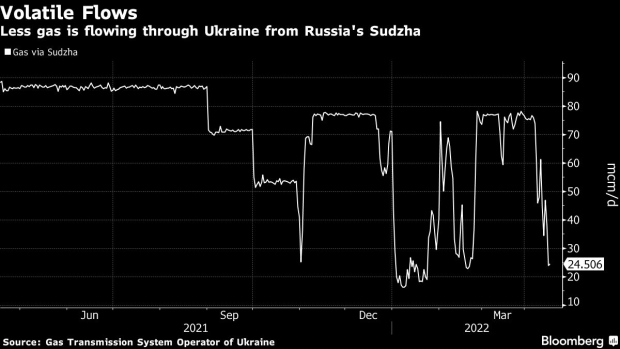Apr 19, 2022
European Gas Falls to Lowest Since Russian Invasion of Ukraine
, Bloomberg News

(Bloomberg) -- European natural gas extended its decline to the lowest level since the start of Russia’s war in Ukraine, amid warmer weather and signs from the Kremlin that payment for the fuel in rubles isn’t expected until next month.
Benchmark Dutch gas futures fell as much as 12% to 84 euros per megawatt hour, the lowest level since Feb. 23, the day before the Russian invasion. The front-month contract dropped for a second consecutive session, after settling 9.2% lower on April 14, ahead of the Easter holidays.
The market has been focused on shipments from Russia, its largest supplier, particularly following President Vladimir Putin’s demand last month that “unfriendly” buyers pay for gas in rubles. The European Union’s lawyers have drafted a preliminary finding that the payment mechanism would violate the bloc’s sanctions.
There is still “some time” for Europe to pay for Russian gas shipments in rubles with payments for April shipments mainly “due sometime in May,” Kremlin spokesman Dmitry Peskov said on Monday. He declined to comment on whether any customers have agreed to pay in rubles or set up accounts as mandated.
Above-average temperatures in southeast Europe are set to expand into the mid-continent next week, Maxar said in a report. That could relieve some pressure on demand for natural gas. Iberia will be colder than normal, the forecaster added.
Softer Fundamentals
Even before the war in Ukraine, Europe was dealing with an energy supply crunch and competing with Asia for cargoes of liquefied natural gas. Spot LNG prices in northeast Asia have been subdued as pandemic-related lockdowns weigh on demand.
“Gas prices have come down quite a bit as short-term fundamentals soften,” said Edmund Siau, lead analyst for gas and LNG at consultants FGE. Demand destruction and fuel switching have eased pressures on European gas prices but competition from Asia looms, he said. “Traders are wondering what Asia is going to do with China’s lockdowns and what the plan is to restock before winter,” he said.
Still, Russian natural gas flows to Europe via Ukraine are expected below capacity on Tuesday, after orders for supplies dropped before Easter. Gazprom PJSC has said its shipments are in line with client requests.
While gas arriving in Ukraine from Russia’s Sokhranovka network point has been relatively steady, flows from the Sudzha station have slumped in recent days. Flows via the Nord Stream link remain stable, grid data show.
Russia’s military shelled southern and eastern Ukraine overnight, with President Volodymyr Zelenskiy saying Moscow had launched a new campaign focused on conquering the eastern Donbas region.
Dutch front-month futures traded 3.8% lower at 92 euros per megawatt-hour by 9:52 a.m. Amsterdam time. The U.K. equivalent fell 3.5%.
©2022 Bloomberg L.P.






